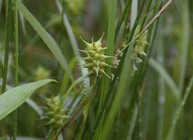Cyperaceae taxon details
Carex dickinsii Franch. & Sav.
1676829 (urn:lsid:marinespecies.org:taxname:1676829)
accepted
Species
Carex coreana L.H.Bailey · unaccepted
recent only
Franchet, A. & Savatier, L. (1878). Enumeratio plantarum : in Japonia sponte crescentium hucusque rite cognitarum, adjectis descriptionibus specierum pro regione novarum, quibus accedit determinatio herbarum in libris japonicis. 2., available online at https://www.biodiversitylibrary.org/page/6210685#page/3/mode/1up
page(s): 581 [details]
page(s): 581 [details]
Description Perennials. loosely caespitose, with long creeping rhizomes. Stems 20-70 cm tall, obtusely trigonous, smooth on lower part...
Taxonomic remark Source in seed data: wcs Update namepublishedIn from Enum. Pl. Jap. 2: 581. 1878 [prob. Apr 1878] to Enum. Pl. Jap. 2: 581...
Taxonomic remark Les bractées dépourvues de gaines, les épillets femelles formés de fleurs nombreuses, les périgynes largement ovales...
Description Perennials. loosely caespitose, with long creeping rhizomes. Stems 20-70 cm tall, obtusely trigonous, smooth on lower part and scabrid on top. Leaves longer than or equaling stem, 4-8 mm wide, light green, scabrous. Basal sheaths yellowish brown, soft, slightly fibrillose. Involucral bracts leaflike, longer than inflorescence, usually without sheaths or sometimes lowermost one shortly sheathed. Inflorescences spikes usually 3; terminal spikes male, clavate, 1.5-2 cm long, shortly pedunculate; lateral spikes female, rather approximate, subglobose or oblong-ovate, 1.5-2 cm long, densely many flowered, nearly sessile. Staminate scales pale brown, midrib broadly light green, apex acuminate. Pistillate scales pale brown, midrib broad, green, apex acuminate or shortly aristate. Perigynia stramineous or yellowish brown, obliquely patent, later horizontally patent or reflexed, much longer than pistillate scales, broadly ovate or ovate, inflated trigonous, ca. 10 mm long, 5-veined abaxially, apex gradually narrowed to a stiff beak, mouth bidentate. Achenes broadly rhomboid, trigonous, ca. 3 mm long. Stigmas 3. [details]
Taxonomic remark Source in seed data: wcs Update namepublishedIn from Enum. Pl. Jap. 2: 581. 1878 [prob. Apr 1878] to Enum. Pl. Jap. 2: 581...
Taxonomic remark Source in seed data: wcs Update namepublishedIn from Enum. Pl. Jap. 2: 581. 1878 [prob. Apr 1878] to Enum. Pl. Jap. 2: 581 (1878), information provided by Alan E. on email Jun. 07 2021 More details could be found in [details]
Taxonomic remark Les bractées dépourvues de gaines, les épillets femelles formés de fleurs nombreuses, les périgynes largement ovales...
Taxonomic remark Les bractées dépourvues de gaines, les épillets femelles formés de fleurs nombreuses, les périgynes largement ovales à la base, distinguent bien le C. Dickinsii du C. rostrata Michx (C. Michauxiana Boeck.). Par ses bractées et la forme du périgyne, il se rapproche davantage du C. intumescens Rudge; mais cette espèce a des épillets femelles pauciflores et ses périgynes sont parcourus par de nombreuses nervures très-fines qui disparaissent presque à la maturité. Le C. Grayi, dont les bractées sont également dépourvues de gaines, a ses épillets femelles, quoique formés de 15-20 fleurs seulement, presque une fois plus larges (3-4 cent.), à cause de la dimension du périgyne qui atteint jusqu'à 18 mill. de longueur. Le C. lupulina s'éloigne davantage par sa bractée inférieure plus ou moins engainante et surtout par les écailles des fleurs mâles et femelles qui ne sont pas dissemblables et beaucoup plus étroites. [details]
Cyperaceae Working Group. (2025). [see How to cite]. Global Cyperaceae Database. Carex dickinsii Franch. & Sav.. Accessed at: https://cyperaceae.org/aphia.php?p=taxdetails&id=1676829 on 2025-09-14
Date
action
by
2024-12-10 11:47:54Z
unchecked
db_admin
![]() The webpage text is licensed under a Creative Commons
Attribution 4.0 License
The webpage text is licensed under a Creative Commons
Attribution 4.0 License
Nomenclature
original description
Franchet, A. & Savatier, L. (1878). Enumeratio plantarum : in Japonia sponte crescentium hucusque rite cognitarum, adjectis descriptionibus specierum pro regione novarum, quibus accedit determinatio herbarum in libris japonicis. 2., available online at https://www.biodiversitylibrary.org/page/6210685#page/3/mode/1up
page(s): 581 [details]
basis of record Plants of the World Online (POWO). , available online at https://powo.science.kew.org/ [details]
page(s): 581 [details]
basis of record Plants of the World Online (POWO). , available online at https://powo.science.kew.org/ [details]
Other
additional source
Li, B. Z.; Zhang, S. R. (2024). An updated species checklist and taxonomic synopsis of Cyperaceae in China. <em>Biodiversity Science.</em> 32(7): 24106., available online at https://doi.org/10.17520/biods.2024106 [details] Available for editors  [request]
[request]
 Present
Present  Inaccurate
Inaccurate  Introduced: alien
Introduced: alien  Containing type locality
Containing type locality
Syntype P 00281388, geounit Honshu [details]
From editor or global species database
Description Perennials. loosely caespitose, with long creeping rhizomes. Stems 20-70 cm tall, obtusely trigonous, smooth on lower part and scabrid on top. Leaves longer than or equaling stem, 4-8 mm wide, light green, scabrous. Basal sheaths yellowish brown, soft, slightly fibrillose. Involucral bracts leaflike, longer than inflorescence, usually without sheaths or sometimes lowermost one shortly sheathed. Inflorescences spikes usually 3; terminal spikes male, clavate, 1.5-2 cm long, shortly pedunculate; lateral spikes female, rather approximate, subglobose or oblong-ovate, 1.5-2 cm long, densely many flowered, nearly sessile. Staminate scales pale brown, midrib broadly light green, apex acuminate. Pistillate scales pale brown, midrib broad, green, apex acuminate or shortly aristate. Perigynia stramineous or yellowish brown, obliquely patent, later horizontally patent or reflexed, much longer than pistillate scales, broadly ovate or ovate, inflated trigonous, ca. 10 mm long, 5-veined abaxially, apex gradually narrowed to a stiff beak, mouth bidentate. Achenes broadly rhomboid, trigonous, ca. 3 mm long. Stigmas 3. [details]Diagnosis Pallide virens, subflaccida; rhizoma repens, tenue; culmi ½-2 pedales, graciles, obtuse trianguli, apice tantum sub spiculis scabri, ad medium usque foliati; folia culmos parum superantia, 3-4 mill. lata, marginibus et subtus scaberrima, longe vaginantia, vaginis biligulatis, ligulis conformibus, ovatis, 2-3 mill. longis; bractea inferior evaginata, foliacea, culmos æquans vel superans; spicula mascula solitaria, 1½-2 poll. longa, 3 mill. lata, linearia, longe pedunculata, squamis sordide albescentibus, oblongis, obtusis vel acutis, dorso uninerviis, nunc muticis, nunc breviter aristatis, arista scabra; spiculæ feminæ 2, subsessiles, con-contiguæ, densiflore, 25-40 floræ, subglobosæ, vel ovatæ, vel obovatæ, 1¼-3 cent. longæ, 1½-2 cent. latæ, squamis perigynii circiter dimidium æquantibus, triplo angustioribus, ovatis, lateribus sordide rufescentibus, dorso virescentibus, trinerviis, nervo medio in aristam scabram, brevem, producto; stylus trifidus; perigynium maturum, 10-12 mill. longum, basi late ovatâ, 3 mill. latâ, stramineum (juvenile fuscum), 13-15 nervium, in rostrum longum productum, rostro ore levi, bifido; achænium laxe inclusum, late ovatum, acute trigonum, fuscum, papilloso scabridum, apice attenuatum longe mucronatum. [details]
Taxonomic remark Source in seed data: wcs Update namepublishedIn from Enum. Pl. Jap. 2: 581. 1878 [prob. Apr 1878] to Enum. Pl. Jap. 2: 581 (1878), information provided by Alan E. on email Jun. 07 2021 More details could be found in [details]
Taxonomic remark Les bractées dépourvues de gaines, les épillets femelles formés de fleurs nombreuses, les périgynes largement ovales à la base, distinguent bien le C. Dickinsii du C. rostrata Michx (C. Michauxiana Boeck.). Par ses bractées et la forme du périgyne, il se rapproche davantage du C. intumescens Rudge; mais cette espèce a des épillets femelles pauciflores et ses périgynes sont parcourus par de nombreuses nervures très-fines qui disparaissent presque à la maturité. Le C. Grayi, dont les bractées sont également dépourvues de gaines, a ses épillets femelles, quoique formés de 15-20 fleurs seulement, presque une fois plus larges (3-4 cent.), à cause de la dimension du périgyne qui atteint jusqu'à 18 mill. de longueur. Le C. lupulina s'éloigne davantage par sa bractée inférieure plus ou moins engainante et surtout par les écailles des fleurs mâles et femelles qui ne sont pas dissemblables et beaucoup plus étroites. [details]
Translation The bracts have no sheaths, the female spikelets have numerous flowers, and the perigynia are broadly ovate at the base, all of which distinguish C. dickinsii from C. rostrata Michx (C. Michauxiana Boeck.). The bracts and shape of the perigynia are closer to those of C. intumescens Rudge, but this species has female spikelets with fewer flowers and its perigynia are covered with numerous very fine veins that almost disappear at maturity. C. Grayi, whose bracts are also devoid of sheaths, has its female spikelets, although formed of only 15-20 flowers, almost once as wide (3-4 cm), due to the size of the perigynum, which reaches up to 18 mm in length. C. lupulina differs further in its more or less sheathing lower bract and especially in the scales of the male and female flowers, which are not dissimilar and much narrower. [details]
Translation Plant pale green, a bit flaccid; rhizome creeping, thin; culms ½-2 feet high, slender, obtusely triangular, only scabrous at the apex under the spikelets, with leaves inserted up to the middle; leaves slightly exceeding the culms, 3-4 mm wide, very scabrous at the margins and underneath, long sheathing, apex of sheaths with a ligule on both sides, both ligules similar, ovate, 2-3 mm long; lower bract sheathless, with a blade equaling or exceeding the culms; male spikelet solitary, 1½-2 inches long, 3 mm wide, linear, long pedunculate, with dirty whitish scales, oblong, obtuse or acute, with a single nerve on the back, sometimes awnless, sometimes with a short awn, awn scabrous; female spikelets 2, subsessile, contiguous, densely floriferous, 25-40 flowers, subglobose, or ovate, or obovate,1¼-3 cm long, 1½-2 cm wide, pistillate scales covering about half the length of the perigynia and a third of its width, ovate, sides dirty reddish, back greenish, three-nerved, middle nerve ending in a short, scabrous arista; style trifid; mature perigynium, 10-12 mm long, base broadly ovate, 3 mm wide, stramineous (juvenile dark brown), 13-15 nerves prolonging into a long beak. Beak with smooth edges, ending with two teeth; achene loosely enclosed, broadly ovate, acutely triangular, dark brown, papillose scabrid, apex attenuated, long mucronate. [details]
| Language | Name | |
|---|---|---|
| Japanese | オニスゲ | [details] |
Photos of Cyperaceae by Hoshino Labo. from Japan
To Biodiversity Heritage Library (1 publication)
To Biodiversity Heritage Library (3 publications) (from synonym Carex coreana L.H.Bailey)
To European Nucleotide Archive, ENA (Carex dickinsii)
To GenBank (4 nucleotides; 94 proteins)
To International Plant Names Index (IPNI)
To International Plant Names Index (IPNI) (from synonym Carex coreana L.H.Bailey)
To Plants of the World Online (from synonym Carex coreana L.H.Bailey)
To Plants of the World Online
To Biodiversity Heritage Library (1 publication)
To Biodiversity Heritage Library (3 publications) (from synonym Carex coreana L.H.Bailey)
To European Nucleotide Archive, ENA (Carex dickinsii)
To GenBank (4 nucleotides; 94 proteins)
To International Plant Names Index (IPNI)
To International Plant Names Index (IPNI) (from synonym Carex coreana L.H.Bailey)
To Plants of the World Online (from synonym Carex coreana L.H.Bailey)
To Plants of the World Online




